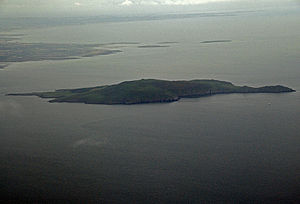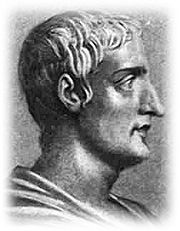
Drumanagh
Encyclopedia

Headland
A headland is a point of land, usually high and often with a sheer drop, that extends out into a body of water.Headland can also refer to:*Headlands and bays*headLand, an Australian television series...
20 km north of Dublin, Ireland
Ireland
Ireland is an island to the northwest of continental Europe. It is the third-largest island in Europe and the twentieth-largest island on Earth...
. It features a 19th century Martello tower
Martello tower
Martello towers are small defensive forts built in several countries of the British Empire during the 19th century, from the time of the Napoleonic Wars onwards....
and a large (200,000 m²) iron age
Iron Age
The Iron Age is the archaeological period generally occurring after the Bronze Age, marked by the prevalent use of iron. The early period of the age is characterized by the widespread use of iron or steel. The adoption of such material coincided with other changes in society, including differing...
promontory fort
Promontory fort
A promontory fort is a defensive structure located above a steep cliff, often only connected to the mainland by a small neck of land, thus utilizing the topography to reduce the ramparts needed. Although their dating is problematic, most seem to date to the Iron Age...
which has produced Roman
Roman Empire
The Roman Empire was the post-Republican period of the ancient Roman civilization, characterised by an autocratic form of government and large territorial holdings in Europe and around the Mediterranean....
artefacts.
Some archaeologists
Archaeology
Archaeology, or archeology , is the study of human society, primarily through the recovery and analysis of the material culture and environmental data that they have left behind, which includes artifacts, architecture, biofacts and cultural landscapes...
have suggested the fort was a bridgehead
Bridgehead
A bridgehead is a High Middle Ages military term, which antedating the invention of cannons was in the original meaning expressly a referent term to the military fortification that protects the end of a bridge...
for Roman military campaigns, while others suggest it was a Roman trading colony or a native Irish settlement that traded with Roman Britain
Roman Britain
Roman Britain was the part of the island of Great Britain controlled by the Roman Empire from AD 43 until ca. AD 410.The Romans referred to the imperial province as Britannia, which eventually comprised all of the island of Great Britain south of the fluid frontier with Caledonia...
.
Characteristics
Drumanagh is nearly 900 m. long and 190 m. wide. The area consists of a small peninsula defended by three rows of parallel ditches on the landward side. It is surrounded on three sides by the Irish seaIrish Sea
The Irish Sea separates the islands of Ireland and Great Britain. It is connected to the Celtic Sea in the south by St George's Channel, and to the Atlantic Ocean in the north by the North Channel. Anglesey is the largest island within the Irish Sea, followed by the Isle of Man...
, showing huge erosion that could have reduced its size to the present 44 acres (178,061.8 m²) and may have destroyed evidences of old Roman structures.
The site is privately owned and is a Recorded Monument, protected under the Section 12 of the National Monuments (Amendment) Act, l994, and by a Preservation Order placed on it in 1977. Although its archaeological importance has been known since the 1950s, when ploughing turned up sherds of Roman samian ware, it has not been subject to archaeological excavation, but numerous artefacts have been dug up by illegal metal detectorists. One such collector attempted to sell a trove of Roman coins and ornaments at Sotheby's
Sotheby's
Sotheby's is the world's fourth oldest auction house in continuous operation.-History:The oldest auction house in operation is the Stockholms Auktionsverk founded in 1674, the second oldest is Göteborgs Auktionsverk founded in 1681 and third oldest being founded in 1731, all Swedish...
in London in the 1980s, which was impounded and deposited in the National Museum of Ireland
National Museum of Ireland
The National Museum of Ireland is the national museum in Ireland. It has three branches in Dublin and one in County Mayo, with a strong emphasis on Irish art, culture and natural history.-Archaeology:...
. Since then, a legal dispute over ownership has prevented the artefacts and their provenance from being discussed publicly.
History

Gnaeus Julius Agricola
Gnaeus Julius Agricola was a Roman general responsible for much of the Roman conquest of Britain. His biography, the De vita et moribus Iulii Agricolae, was the first published work of his son-in-law, the historian Tacitus, and is the source for most of what is known about him.Born to a noted...
, then Roman governor of Britain, for an invasion of Ireland in AD 82. The Roman historian Tacitus
Tacitus
Publius Cornelius Tacitus was a senator and a historian of the Roman Empire. The surviving portions of his two major works—the Annals and the Histories—examine the reigns of the Roman Emperors Tiberius, Claudius, Nero and those who reigned in the Year of the Four Emperors...
mentions that Agricola entertained an exiled Irish prince, thinking to use him as a pretext for a possible conquest of Ireland. Agricola, says Tacitus, "crossed in the first ship" and defeated peoples unknown to the Romans until then. He does not specify which body of water he crossed, although many scholars believe it was the Clyde or Forth; however, the rest of the chapter exclusively concerns Ireland
Ireland
Ireland is an island to the northwest of continental Europe. It is the third-largest island in Europe and the twentieth-largest island on Earth...
.
Agricola fortified the coast facing Ireland, and Tacitus recalls that his father-in-law often claimed the island could be conquered with a single legion
Roman legion
A Roman legion normally indicates the basic ancient Roman army unit recruited specifically from Roman citizens. The organization of legions varied greatly over time but they were typically composed of perhaps 5,000 soldiers, divided into maniples and later into "cohorts"...
and auxiliaries
Auxiliaries (Roman military)
Auxiliaries formed the standing non-citizen corps of the Roman army of the Principate , alongside the citizen legions...
. This conquest never happened, but some historians believe that the crossing referred to was in fact a military expedition to Ireland.
Vittorio De Martino argues that there was continuous interaction between Roman Britain and Ireland. Richard Warner suggests that Drumanagh may have been the bridgehead for an invasion of exiled Irish and British adventurers, who, with Roman support, carved out kingdoms for exiled Irish noblemen, and links this with the legend of Tuathal Techtmar, who is said to have been exiled to Britain in the 1st or 2nd century, and returned with an army to seize the kingship. A group of burials on Lambay Island
Lambay Island
Lambay lies off the coast of Fingal / north County Dublin, Ireland in the Irish Sea. It is located north of Ireland's Eye at and is the easternmost point of the Republic of Ireland...
, just off the coast near Drumanagh, contained Roman brooches and decorative metalware of a style also found in Roman Britain from the late first century. Indeed, some archeological discoveries inside Ireland, like Roman jewelry and coins at Tara
Hill of Tara
The Hill of Tara , located near the River Boyne, is an archaeological complex that runs between Navan and Dunshaughlin in County Meath, Leinster, Ireland...
and Clogher
Clogher
Clogher is a village in County Tyrone, Northern Ireland. It lies on the River Blackwater, south of Omagh. The United Kingdom Census of 2001 recorded a population of 309.-History:...
, support the possibility of a Roman invasion of Ireland.
See also
- HiberniaHiberniaHibernia is the Classical Latin name for the island of Ireland. The name Hibernia was taken from Greek geographical accounts. During his exploration of northwest Europe , Pytheas of Massilia called the island Ierne . In his book Geographia Hibernia is the Classical Latin name for the island of...
- Hibernia and Roman EmpireHibernia and Roman EmpireHiberno-Roman relations refers to the relationships which existed between Ireland and the ancient Roman Empire, which lasted from the time of Julius Caesar to the beginning of the 5th century AD...
- History of IrelandHistory of IrelandThe first known settlement in Ireland began around 8000 BC, when hunter-gatherers arrived from continental Europe, probably via a land bridge. Few archaeological traces remain of this group, but their descendants and later Neolithic arrivals, particularly from the Iberian Peninsula, were...
- Roman EmpireRoman EmpireThe Roman Empire was the post-Republican period of the ancient Roman civilization, characterised by an autocratic form of government and large territorial holdings in Europe and around the Mediterranean....
- Tuathal Techtmar

